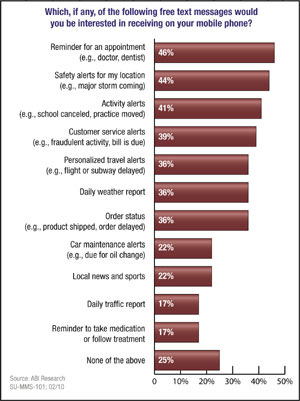September 24, 2010 by Jessica Zorawski
First, it was the shiny Motorola Razor cell phone. Do you remember how cool that was? Then it was the Blackberry, what a commotion that little scrolling ball created in the mobile world! Next, the IPhone made headlines for its amazing picture quality and touch screen capabilities. Now, the talk of the town has shifted away from the look of cell phones and on to their resources. Interests have migrated from the alarm clock function to the ability to text message and use applications. With all these changes occurring within such a short period of time, it’s sometimes difficult for marketers to know where to concentrate their mobile marketing efforts.
The best place to look for your answer is within the facts and statistics that are currently available. Only 35 percent of U.S. adults have mobile devices with the capability of utilizing an application, and of those, only 24 percent actually use the app programs available, according to the Pew Research Center’s Internet & American Life Project. Eleven percent of adults don’t even understand the concept of an “app” and are not sure if their phone is equipped with the capability.
Read more
September 17, 2010 by Jessica Zorawski
The PricewaterhouseCoopers’ Health Research Institute released a study demonstrating the benefits that mobile technology offers in terms of healthcare. The healthcare industry is now packed with mobile devices designed to improve the standard of care and convenience for patients. Forty percent of the respondents surveyed indicated they would pay for mobile health care services.
Mobile technology is not only an aid to consumers, it’s also a new business category for those interested in improving and offering more options for preventative, acute and chronic care. There are already 10,000 medical and healthcare/fitness-related applications available for download to internet-enabled mobile devices, and consumers are catching on to the idea of being able to send data to doctors automatically.
Read more
September 12, 2010 by Jessica Zorawski
The New York Times recently published an article with new statistics regarding adult text messaging usage. Everyone knows that teenagers text, yet the fact that adult usage is continually increasingly is often overlooked and under reported.
Last year, 65 percent of American adults were sending and receiving text messages. That percentage has grown to almost three quarters of all Americans according to the most recent surveys. In his article, Frederic Lardinois of the New York Times reports that “about 50 percent of all adults who use text messaging send between 1 and 10 messages, 25 percent send between 11 and 50 messages a day, 10 send between 50 and 200 messages.”
Read more
August 18, 2010 by Jessica Zorawski
In last year’s Harris Interactive report, the demographic most likely to show interest in receiving a mobile coupon was young, affluent males. Within one year, this has changed dramatically. The same study conducted in 2010 indicates that parents with younger children are the new demographic most highly interested in mobile coupons.

Adults with younger children versus adults with older kids showed varying interest levels. The most interested category of respondents was parents with children 6 or younger, with 35 percent voting “somewhat interested in receiving text alerts with coupons”. This is the same group most likely to clip and redeem paper coupons, so it makes sense that they enjoy the convenience of having a digital coupon as well. Households with older kids were close behind, with 32 percent of respondents indicating interest. Households with no children responded with a 25 percent interest level in getting opt-in text coupons, most likely due to having a larger amount of available income with no children to support.
Read more
August 17, 2010 by Jessica Zorawski
A recent survey completed by ABI Research aimed to uncover consumer preferences regarding informational text messages received from businesses. The results are pertinent to any business in the service industry.

The survey’s results describe the types of text message alerts that consumer’s desire. At the top of the list, with 46 percent affirmation, are reminders for an appointment, specifically for a doctors or dentist appointment. Dozens of medical and dental offices have used Opt It to save money on phone call appointment reminders and are now simply sending a text message to their opted in clients.
Coming in a close second are safety alerts such as major storm warnings. These types of messages received 44 percent of interest from consumers. If your business offers a service that is affected by the weather, try sending your customers weather updates to increase business during good weather and decrease their disappointment when the forecast calls for inclement weather.
Activity alerts, such as school cancelations and schedule changes, interested 41 percent of consumers. Preference was also apparent for customer service alerts regarding bills and travel.
The take-away here is obvious: consumers want to be notified regarding appointments, last minute schedule changes, and weather forecasts. They prefer to be notified via text message. Not a surprise, considering everyone has a cell phone these days, right?
Opt It’s text messaging platform is not just a promotional tool- it’s also a communication tool that can be used to inform consumers. If 46 percent of consumers say they would like to receive appointment reminders via text, it is very likely that your clientele will be interested as well. Try it out free for 30 days.

